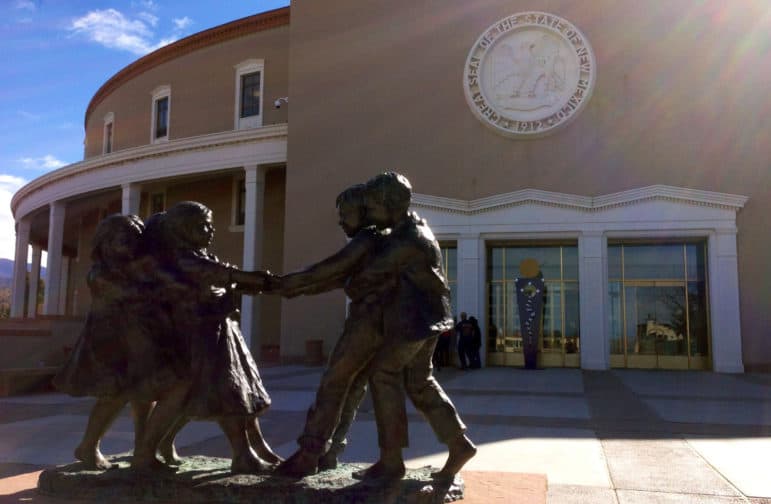
Heath Haussamen / NMPolitics.net
A statue outside the Roundhouse in Santa Fe.
New Mexico lawmakers are delivering on a promise to improve one of the state’s last-in-the-country rankings — the speed of broadband internet.
Several bills are moving through the Legislature, and two have cleared the Senate and House of Representatives and are heading to Gov. Susana Martinez for her consideration. Each would make it easier to expand broadband internet to underserved rural areas where the sparse population makes it difficult for companies to recoup their costs.
House Bill 60 would allow private companies installing fiber optics to share a trench unearthed by the state or a local government. The change reclassifies broadband as an economic development project and exempts it from a constitutional provision that prohibits taxpayer support to private companies.
“Fiber in the ground is still the most reliable and dependable way to get internet,” said Sen. Jacob Candelaria, D-Albuquerque, who co-sponsored the measure with Rep. Carl Trujillo, D-Santa Fe. “I think it’s a big win for our state that this is the first bill going up to the governor’s desk.”
Also advancing to the governor is House Bill 113, sponsored by Rep. Jim Smith, R-Sandia Park, and Sen. Daniel Ivey Soto, D-Albuquerque.
That bill calls on the state Department of Information Technology to leverage broadband money — some of it federal grants for schools — by allowing tribal and local governments to tap into the network. This would create more customers to share any cost.
Many providers will not expand service unless there is sufficient demand to recoup costs.
“House Bill 113 makes it a continuing responsibility of the state’s chief information officer to plan for statewide deployment of broadband, leveraging federal dollars for schools and libraries, ” Sen. Ivey-Soto said in a statement.
Other measures are moving under the sponsorship of Sen. Michael Padilla, D-Albuquerque, whose interim technology committee held a series of meetings last year on broadband. Padilla also serves on the Jobs Council, a panel of lawmakers and business leaders that advises the Legislature.
Padilla sees broadband, the type of internet cable connections that can carry large amounts of data, as essential for job growth throughout the state, even in areas of Bernalillo County that now can’t receive quality service.
The Jobs Council has agreed the state needs 160,000 more base jobs in New Mexico during the coming decade to compensate for employment losses and population growth. Of the nine sectors targeted for expansion, eight are dependent on improved broadband connections — including startups, film and media and even agriculture.
Padilla said many startup and stay-at-home workers would prefer to remain in smaller communities if they had reliable broadband service.
“If we don’t get our hands around it, we’re going to see our small communities in the state dry up,” he said.
Some of what Padilla is proposing is complicated, such as Senate Bill 308. It would reconfigure a consumer fee on voice lines imposed by the state Public Regulation Commission. The bill would require that a certain percent of the fee go to broadband development, among other changes.
Senators approved the bill 42-0 and is scheduled for hearings before House committees this week.
Republican Sander Rue of Albuquerque said the change is long overdue. “This has been bubbling and brewing out there for years,” he said. “It’s good this is going to happen, updating and modernizing our process here to recognize new technologies.”
Padilla said there are some 50 bills or memorials in the Legislature that touch on the need for better broadband. Memorials are sentiments of expression that have no force of law.
Padilla said millions of dollars were awarded to states by the federal government under President Barack Obama as part of the economic stimulus launched after the recession of 2008. New Mexico missed out on much of the funding because it didn’t have a plan in place to show where broadband was needed and how it would get service to underserved communities, Padilla said.
Yet, the need is there. According to an analysis of one bill, more than 90 percent of schools are connected to fiber, “among the highest in the nation, yet school connection speeds are among the slowest in the nation.”
Contact Bruce Krasnow at brucek@sfnewmexican.com.